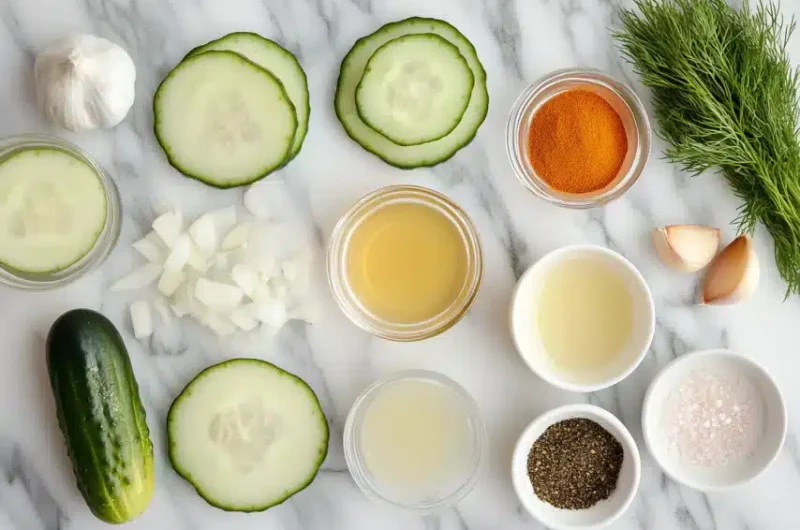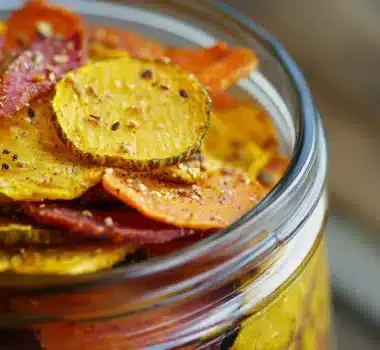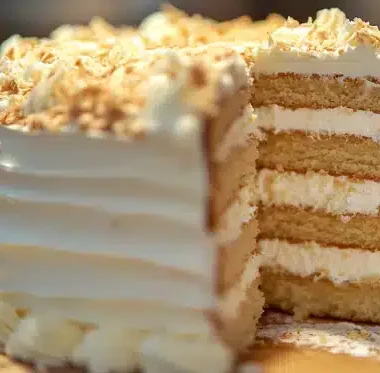Pickle chips, those crunchy, tangy delights, are a staple snack in many households. But have you ever wondered what are pickle chips made of? They seem so simple, yet they hold a surprising complexity of flavors and textures. This article aims to unveil the mystery, diving deep into the core ingredients and the processes that transform cucumbers into these addictive snacks. Whether you’re a pickle enthusiast or just curious about what’s in pickle slices, this guide will give you a full understanding of the components of pickle chips. From the type of cucumber used to the spices and brine, we’ll cover all the key elements, so that you can understand and perhaps even create your very own unique batches of these yummy treats.
The Core Component: Pickling Cucumbers
At the heart of every pickle chip lies the humble cucumber. However, not just any cucumber will do. Pickling cucumbers are the preferred choice because they are specifically bred for this purpose. These cucumbers are typically smaller, firmer, and have fewer seeds than their regular counterparts. This structural difference makes them less likely to turn mushy or waterlogged during the pickling process. Because of these traits, the pickling cucumber ensures the pickle chip ingredients deliver the desired crispiness and texture that is so important for a pickle slice. Furthermore, their skin is thinner, which facilitates the absorption of the brine, allowing for a better and richer flavor experience.
Different varieties of pickling cucumbers
Several varieties of pickling cucumbers are available, each with its own unique qualities. Some popular varieties include the National Pickling, the Kirby, and the Gherkin. The National Pickling cucumber is a classic choice, known for its straight shape, uniform size, and excellent pickling performance. Kirby cucumbers are slightly smaller and have a bumpy skin, making them particularly suitable for small pickle chips or whole pickles. Gherkin cucumbers are the smallest of the pickling varieties, perfect for baby or cornichon pickles. The variety of cucumber used plays a huge role in the texture and taste of the finished product, adding complexity to the pickle chip recipe.
The Brine Basics: Liquid Ingredients
The brine is the lifeblood of any pickle chip. It’s the liquid that not only preserves the cucumbers but also imparts flavor. Vinegar is a key component, providing the acidity necessary to prevent bacterial growth and create the tangy taste that pickle chips are known for. White vinegar is a common choice due to its neutral flavor, but apple cider vinegar can also be used for a slightly different profile. The brine also includes water, usually distilled or filtered, to dilute the vinegar to the right concentration. Salt is another essential ingredient, it helps to preserve the cucumbers and contributes to the texture as well. A little sugar or another sweetener, like honey or agave, is often added to balance out the sourness. This mixture of liquid ingredients is what transforms a cucumber into a delicious pickle slice.
The role of vinegar
The type of vinegar used greatly influences the flavor of pickle chips. White vinegar is the most commonly used choice due to its neutral flavor, which allows other spices and seasonings to shine through. Apple cider vinegar, on the other hand, offers a slightly fruity and less sharp tang. The acidity of the vinegar is the most important part, that helps to prevent the growth of unwanted bacteria, thus preserving the cucumbers. Also, it is key in the pickling process to ensure that the cucumbers are preserved safely and have a long shelf life, therefore components of pickle chips greatly depend on vinegar.
Enhancing Flavor: Pickling Spices and Aromatics
While the brine provides the foundation for the flavor, it’s the pickling spices and aromatics that add depth and complexity. Dill is a classic, lending its herbaceous notes, often used in pickle chip recipe. Mustard seeds offer a pungent, peppery flavor, while coriander seeds contribute a warm, citrusy element. Peppercorns, both black and white, add a touch of spice. Garlic cloves provide a pungent, savory note. Fresh herbs, particularly fresh dill, can be used instead of their dried counterparts for a more vibrant flavor. The combination of spices and aromatics is what creates the unique character of each batch of pickle chips. They’re a fundamental part of pickle chip ingredients.
Fresh vs. dried herbs
The choice between fresh and dried herbs in pickle chip recipe can greatly affect the final flavor. Fresh herbs, like fresh dill, have a brighter and more vibrant taste, contributing a fresh, summery aroma to the pickles. Dried herbs, on the other hand, offer a more concentrated and intense flavor. The key is to adjust the quantities accordingly. For example, you might need to use double or triple the amount of fresh dill compared to dried dill. Ultimately, using fresh herbs, especially dill, creates a more dynamic and layered taste in pickle slices, making the pickle chip composition richer and more aromatic.
The Pickling Process: From Cucumber to Chip
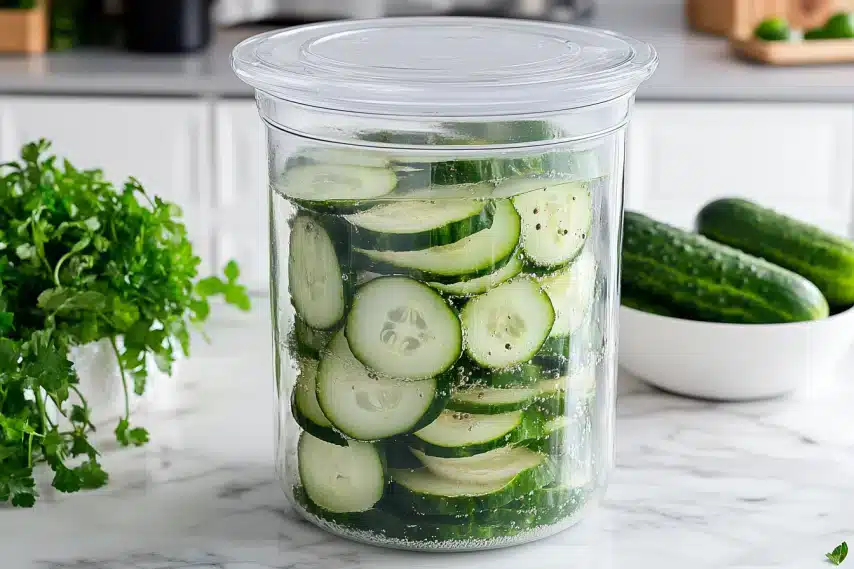
The journey from cucumber to pickle chip involves a meticulous process. First, the cucumbers are washed and sliced into the desired chip shape. Then, the brine, which is prepared by combining vinegar, water, salt, and sugar, with added spices and aromatics is heated. The brine is poured over the cucumbers, ensuring that they are fully submerged. Some pickle chips are made using a fermentation process, which takes a bit longer. However, many recipes, especially refrigerator pickles, do not use fermentation; instead, they rely on the acidity of the brine for preservation. The cucumbers absorb the brine, transforming them into crunchy and tangy pickle chips.
Fermentation vs Refrigerator
The type of pickling determines the method of preservation for your pickle chips. Refrigerator pickles rely on the high acidity of the brine to inhibit bacterial growth and they require refrigeration. These pickles are quick to prepare and have a fresh, crisp taste. Fermented pickles, on the other hand, undergo a process in which beneficial bacteria convert the natural sugars in the cucumbers into lactic acid. This lowers the pH of the pickles, preserving them. Fermentation produces a complex flavor and softer texture. Therefore, depending on the desired results, you can choose between refrigerator pickles and fermented pickles to understand the pickle chip composition.
The Science Behind Crispness
Maintaining the crispness of pickle chips is essential. Calcium chloride, often called pickling crisp, is a food-grade additive that can help keep cucumbers firm by strengthening their cell walls. The high salt concentration of the brine also plays a part in this, which draws water out of the cucumbers, leading to a tighter texture. The temperature of the brine, the soaking time, and the size of the cucumber pieces also affect their crispness. A colder brine and a shorter soaking time can help to maintain a firm texture. The best pickle slices have this wonderful balance between crunchiness and tanginess.
How salt affects texture
Salt plays a huge role in the texture of the pickle chip. It helps to draw out excess water from the cucumbers, making them more firm. Also, salt aids in the preservation process, preventing microbial growth and making sure that the cucumbers remain safe to consume. Too much salt can result in a very hard texture, while too little salt can lead to soft, mushy pickles. Therefore, the proper amount of salt is critical to achieving the right texture and flavor in the pickle chip ingredients. The salt content affects the overall structure of pickle slices.
Variations in Pickle Chip Recipes
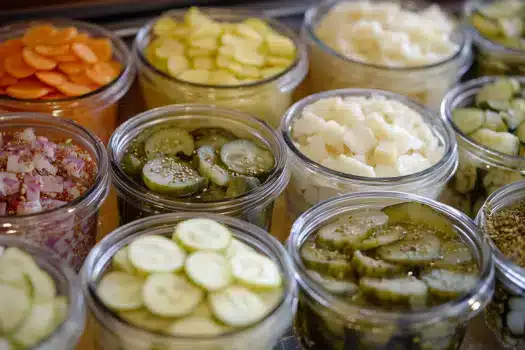
The world of pickle chips is diverse. The dill pickle chip is a classic, characterized by its use of fresh dill and garlic for a tangy and herbaceous flavor. Bread and butter pickle chips offer a sweeter profile, often containing sugar, turmeric and mustard seed in the brine. Spicy pickle chips introduce heat with the addition of red pepper flakes or jalapenos. There are also regional variations, such as sweet pickles, or spicy garlic pickles, and others, each having its own unique blend of spices and flavors. The flexibility of the basic recipe allows for a wide range of tastes. The pickle chip composition is very versatile.
Regional variations
Different regions often have their own unique takes on pickle chips. For example, some southern states in the USA have sweet pickle varieties, characterized by a higher sugar content. In other parts of the world, you might find pickle recipes that include different spices like ginger, or turmeric, or even hot chilies. This wide variety shows the diversity and flexibility of the basic pickle recipe. Exploring regional variations can lead to discovering new favorite flavors and ways to enjoy pickle slices. Therefore, exploring the different pickle chip recipe and variations is very interesting.
Understanding Commercial Pickle Chip Production
Commercial pickle chip production relies on automated processes designed for maximum efficiency. Machines typically wash, sort, and slice the cucumbers. Then, the cucumbers are placed into large jars, and pre-made brine is poured over them. To extend shelf life, manufacturers often use preservatives like sodium benzoate and potassium sorbate in jarred pickles. As a result, commercially made pickle chips might include more additives than homemade varieties. The primary goals are to maintain a consistent taste, texture, and a long shelf life while ensuring that the pickles are safe to eat.
Homemade vs. commercial
There are some key differences between homemade and commercially made pickle chips. Homemade pickles are typically made in small batches, using fresh ingredients and natural spices. They tend to be more customizable, allowing for different variations in taste and texture. Commercial pickles, on the other hand, are mass-produced, often using standardized recipes and preservatives to ensure consistent results and long shelf life. While commercial options are convenient, homemade pickle slices often have a fresher and more vibrant flavor. Therefore, while commercially made pickle chips are practical, homemade varieties offer a fresher taste, and the satisfaction of making them yourself.
FAQs About What Are Pickle Chips Made Of?
Are pickle chips healthy?
Pickle chips can be a low-calorie snack but may have high sodium content. They provide some vitamins and probiotics from the fermentation process.
Can I make pickle chips without sugar?
Yes, you can make pickle chips without sugar. The flavor will be more tangy but still enjoyable.
What’s the difference between dill pickles and other pickle chips?
Dill pickle chips are made with fresh dill, while other variations may use different spices and flavorings like mustard or red pepper.
Can I reuse pickle brine?
It’s generally not recommended that you reuse pickle brine, as it can lose its acidity and might not be safe for further pickling.”
“How do companies make pickle chips commercially?”
“Companies produce commercially made pickle chips using large-scale automated processes with standardized recipes. They often include preservatives.”
Do pickle chips contain a lot of sodium?
Yes, pickle chips can have a high sodium content because of the salt used in the brine. Therefore, they should be eaten in moderation.
How do pickle chips get their crunch?
The crispness factors in pickle chips are achieved through a combination of the type of cucumbers, the brine, and pickling crisp.
What’s the shelf life of pickle chips?
Homemade refrigerator pickles last for several weeks when properly stored in the fridge, while commercially jarred pickles may last much longer due to the added preservatives.
Conclusion
Pickle chips are more than just a simple snack; they are a product of careful selection of ingredients and a specific process. Understanding what are pickle chips made of reveals the art and science of pickling. From pickling cucumbers to the brine, the spices and aromatics, and the various methods of pickling, each step contributes to the unique characteristics of the final product. Whether you prefer the classic dill flavor or a more adventurous spicy profile, experimenting with homemade recipes can be a fun and delicious experience. So, now that you know what goes into pickle slices, feel free to try making your own batch at home! Happy pickling!
External Link: For a detailed guide on choosing the best pickling cucumbers, this guide will help you: https://www.foodnetwork.com/how-to/packages/food-network-essentials/what-are-the-best-pickling-cucumbers

